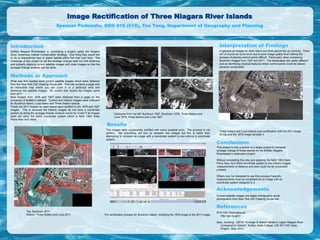
RS powerpoint
- 1. Image Rectification of Three Niagara River Islands Spencer Podsiadlo, GEG 418 (518), Tao Tang, Department of Geography and Planning Buffalo Niagara Riverkeeper is completing a project called the Niagara River Greenway Habitat Conservation Strategy. One thing they would like to do is characterize loss of island habitat within the river over time. The challenge of this project is not the acreage change itself but first obtaining and properly aligning current satellite images with older images so that the acreage change analysis can be done. What was first needed were current satellite images which were obtained from the New York GIS Clearing House site. This site contains a page with an interactive map where you can zoom in to a particular area and download the satellite images. By current that means the images came from 2011. Next images from 1978 and 1927 were obtained from a page on the University of Buffalo’s website. Current and historic images were collected for Buckhorn Island, Luna Island and Three Sisters Islands. Finally the 2011 images for each island were rectified to the 1978 and 1927 images. This is because the historic images do not have a coordinate system so doing the acreage change analysis would be invalid if all images were not using the same coordinate system which is NAD 1983 State Plane New York West. Methods or Approach Introduction References Interpretation of Findings Conclusions Results Acknowledgements Top: Buckhorn 2011. Bottom: Three Sisters and Luna 2011. Clockwise from top left: Buckhorn 1927, Buckhorn 1978, Three Sisters and Luna 1978, Three Sisters and Luna 1927. The images were successfully rectified with some possible error. The process is not perfect. Not everything will line up between two images but this is better than attempting to compare an image with a coordinate system to one without a coordinate system. The rectification process for Buckhorn Island, rectifying the 1978 image to the 2011 image. In general all images for each island and time period line up correctly. There will of course be some error due to poor image quality thus making the process of placing control points difficult. Particularly when comparing Buckhorn images from 1927 and 2011. The landscapes are vastly different and so identifying physical features where control points could be placed became complicated. Three Sisters and Luna Islands post-rectification with the 2011 image on top and the 1978 image beneath it. This project is only a portion of a larger project to complete acreage change of these islands for the Buffalo Niagara Riverkeeper’s restoration project. Without completing this step and applying the NAD 1983 State Plane New York West coordinate system to the historic images, measurements of distance and area could not be conducted properly. Others may be interested to use this process if specific measurements must be completed for an image with no coordinate system assigned to it. Current satellite images are digital orthographic aerial photographs from New York GIS Clearing House site. NYS GIS Clearinghouse http://gis.ny.gov/ Qiao, Jundong. (2014) “Acreage of Island Habitat in Upper Niagara River Compared to Historic”. Buffalo State College, CIE 507 GIS Class Project. May, 2014.